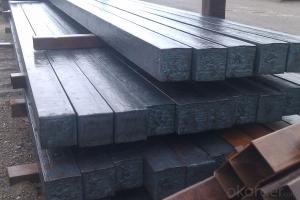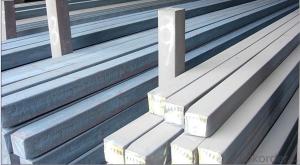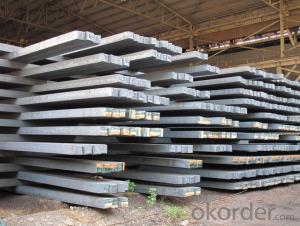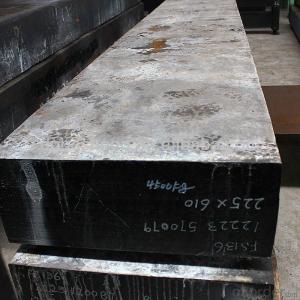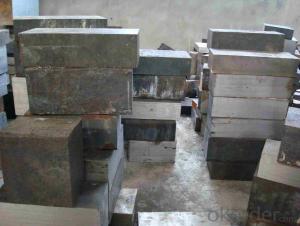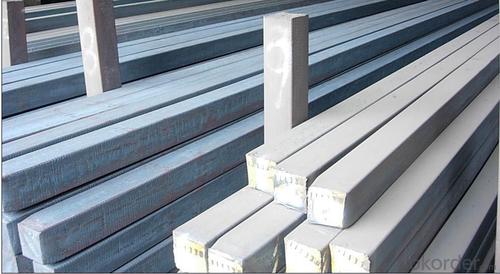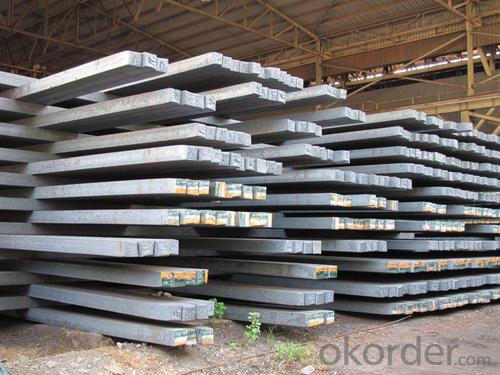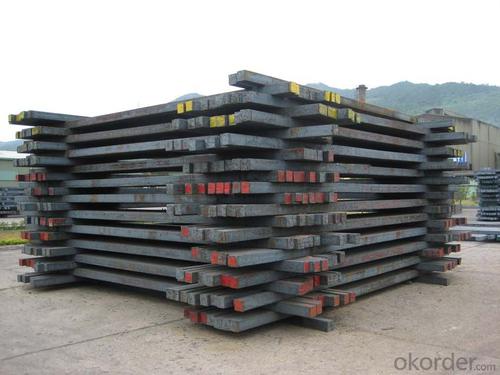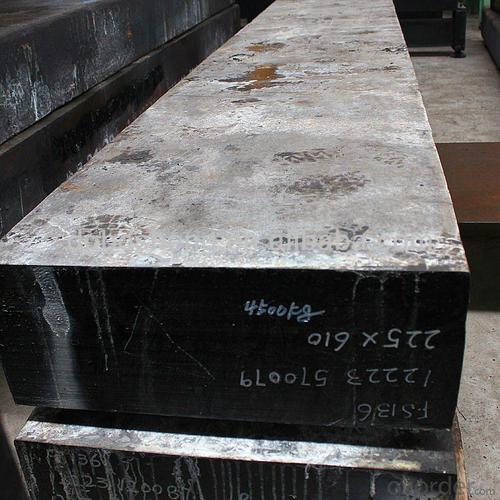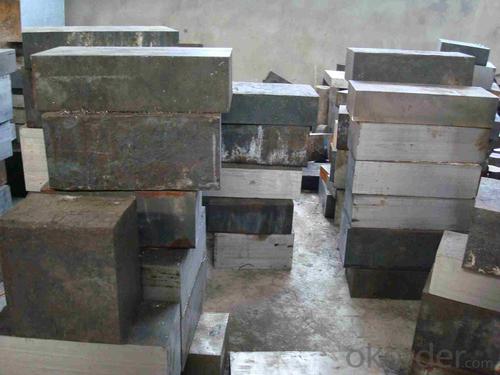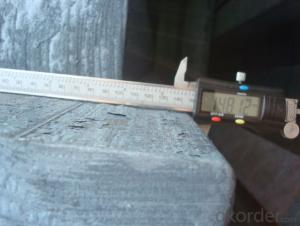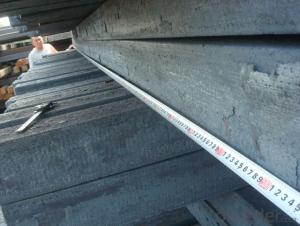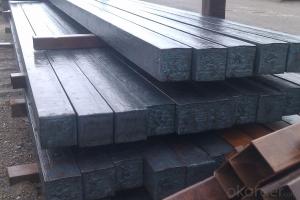Prime quality square alloy steel billet 135mm Q235
- Loading Port:
- Tianjin
- Payment Terms:
- TT OR LC
- Min Order Qty:
- 100 m.t.
- Supply Capability:
- 10000 m.t./month
OKorder Service Pledge
OKorder Financial Service
You Might Also Like
Structure of Prime quality square alloy steel billet 135mm Q235

Description of Prime quality square alloy steel billet 135mm Q235
1. Prepainted steel coil is coated with organic layer, which provides higher anti-corrosion property and a longer lifespan than that of galvanized or galvalume steel sheets.
2. The base metals for prepainted steel coil consist of cold rolled, HDGI Steel, electro-galvanized and hot-dip alu-zinc coated steel. The finish coats of prepainted steel coil can be classified into groups as follows: polyester, silicon modified polyesters, polyvinylidene fluoride, high-durability polyester, etc.
3. The production process has evolved from one-coating-and-one-baking to double-coating-and-double-baking, and even three-coating-and-three-baking.
4. The color of the prepainted steel coil has a very wide selection, like orange, cream-colored, dark sky blue, sea blue, bright red, brick red, ivory white, porcelain blue, etc.
5. The prepainted steel coils can also be classified into groups by their surface textures, namely regular prepainted sheets, embossed sheets and printed sheets.

Main Feature of Prime quality square alloy steel billet 135mm Q235
Uncoated CR steel sheet
With the features of in line with the international highest standards in demension and shape, excellent surface finish and properties, the products are mainly used in home appliance and automobile industries.
Galvanized steel sheet(include HDG and EG)
With the features of good corrosion resistance, the products are mainly used in automobile, home appliance, electronics, building and machinery manufacture industries, etc.
Precoated steel sheet
With the features of enviromental protection and good processablility, long lasting surface durability, rich in colors, the products are maily used in building, home appliance and furniture industries, etc.
Applications of Prime quality square alloy steel billet 135mm Q235
Construction
Manufacture anticorrosion, industrial and civil architecture roof boarding, roof grille
Light industries
Home appliance's case, civil chimney, kitchen utensils
Auto industry
Corrosion resistant parts of cars
Agriculture
Food storage, meat and aquatic products' freezing and processing equipment
Commerce
Equipments to store and transport materials, and packing implements

Specifications of Prime quality square alloy steel billet 135mm Q235
Product | Prime quality square alloy steel billet 135mm Q235 |
Material Grade | SGCC / SGCH / DX51D+AZ, etc |
Thickness | 0.6-3.0mm |
Width | 500-1500mm |
Tolerance | Thickness: +/-0.02mm , Width:+/-2mm |
Zinc-coating | Z30-150g/m2 |
Technique | Raw material: Hot rolled steel coil --> Cold rolled_>hot dipped galvalume |
Surface | Dried, Chromated, Unoiled |
Spangle | Regular spangle , small spangle, zero spangle |
ID | 508MM 610MM |
Coil weight | 1-25MT |
Export package | Cardboard inner sleeves, Waterproof paper, galvanized steel covered and steel strip packed |
FAQ of Prime quality square alloy steel billet 135mm Q235
We have organized several common questions for our clients,may help you sincerely:
1. How Can I Visit There?
Our company is located in Tianjin City, China, near Beijing. You can fly to Tianjin Airport Directly. All our clients, from home or aboard, are warmly welcome to visit us!
2. How Can I Get Some Sample?
We are honored to offer you sample.
3. Why choose CNBM?
Our delivery time about 15-20days for standard sizes, if you have other requirements like hardness, quanity and width ,it is about 20-40days. But don't worry we also try our best for the delivery time ,because time longer and our cost is higher.
- Q: How to purchase suitable billet heating furnace
- Choice can not be blind, you can not just look at the price, the choice of advice you consult more manufacturers, and then use the exclusion method to determine your final goal. Online can take a look at live video, more reference.
- Q: How are steel billets used in the manufacturing of pipeline fittings?
- Steel billets are used in the manufacturing of pipeline fittings by being heated and shaped into the desired form. They serve as the raw material that is then further processed and machined to create various types of fittings such as elbows, tees, reducers, and flanges. The steel billets undergo a series of forging, cutting, and welding processes to achieve the required dimensions and specifications for the pipeline fittings.
- Q: How are steel billets used in the manufacturing of heavy machinery?
- Steel billets are used in the manufacturing of heavy machinery as they serve as the raw material for forging, casting, and machining processes. These billets are heated, shaped, and transformed into various components such as gears, shafts, frames, and structural parts, which are essential building blocks for constructing heavy machinery. The high strength and durability of steel billets make them ideal for withstanding the heavy loads and harsh conditions that heavy machinery often operates in.
- Q: What are the different steelmaking processes used for producing steel billets?
- Steel billets can be produced using various steelmaking processes, each with its own advantages and limitations. These processes differ in terms of efficiency, cost-effectiveness, and the quality of the steel they produce. Some commonly used processes for steel billet production include: 1. Electric Arc Furnace (EAF): By melting recycled steel scrap using an electric arc, the EAF process offers flexibility and the ability to produce steel with different compositions. It is also considered environmentally friendly. 2. Basic Oxygen Furnace (BOF): The BOF process involves blowing oxygen into molten iron to remove impurities and control steel composition. It is commonly used for high-volume steel production and is known for its high productivity. 3. Induction Furnace: Through electromagnetic induction, the induction furnace process efficiently heats steel scrap. It is commonly used for small-scale steel production and offers precise temperature control. 4. Continuous Casting: Molten steel is poured into a water-cooled mold in the continuous casting process, resulting in solidified billets. This process boasts high production rates and consistent steel quality. 5. Ingot Casting: Molten steel is poured into molds to create ingots in the ingot casting process, which can later be processed into billets. While less commonly used due to lower efficiency and quality compared to continuous casting, it still has specific applications. The choice of steelmaking process depends on factors such as desired steel quality, production volume, cost considerations, and environmental impact. Steel producers carefully select the most suitable process based on their specific requirements.
- Q: What are the main factors that affect the international trade of steel billets?
- The international trade of steel billets is affected by various factors. These factors include the state of the global economy, government policies and regulations, currency exchange rates, technological advancements, environmental and sustainability considerations, and political stability and geopolitical factors. The global economy plays a vital role in determining the demand and supply of steel billets. Economic growth and stability in major importing and exporting countries impact the overall demand for steel products. A strong economy leads to increased construction and infrastructure projects, boosting the demand for steel billets. Government policies and regulations significantly impact the international trade of steel billets. Trade policies, import/export regulations, and tariffs imposed by governments can directly affect the competitiveness and cost of steel billets in the international market. Currency exchange rates influence the competitiveness of steel billets in international markets. Fluctuations in exchange rates can affect the demand and prices of steel billets. Technological advancements in steel production and manufacturing processes affect the international trade of steel billets. Improvements in production efficiency and the development of new steel grades can give certain countries a competitive advantage. Increasingly, environmental regulations and sustainability concerns are becoming important factors in international trade. Countries with stricter environmental regulations may require steel billet exporters to meet certain standards or obtain certifications, affecting their competitiveness. The demand for sustainable and low-carbon steel products also influences the trade of steel billets. Political stability and geopolitical factors can impact the international trade of steel billets. Political instability, conflicts, or trade disputes can disrupt supply chains and create uncertainties in the international trade of steel billets. In conclusion, the international trade of steel billets is influenced by economic, regulatory, technological, environmental, and geopolitical factors. Stakeholders in the steel industry need to understand and monitor these factors to make informed decisions in the global market.
- Q: How are steel billets used in the manufacturing of castings?
- Steel billets are an important raw material in the manufacturing of castings. Castings are solid metal objects that are formed by pouring molten metal into a mold and allowing it to cool and solidify. Steel billets are typically used as the starting material for this process. To create castings, steel billets are first heated to a high temperature until they become molten. This molten steel is then poured into a mold, which is typically made of sand or metal. The mold is designed to have the desired shape and dimensions of the final casting. Once the molten steel is poured into the mold, it is left to cool and solidify. As the steel cools, it takes on the shape of the mold, forming the desired casting. The cooling process is critical as it determines the strength, hardness, and other mechanical properties of the final product. After the steel has solidified, the mold is removed, and the casting is cleaned and finished. This may involve removing any excess material, such as gates or risers, that were used to facilitate the pouring of the molten metal. The casting may also undergo additional processes, such as machining or heat treatment, to achieve the desired final specifications. In summary, steel billets are used in the manufacturing of castings by being melted and poured into a mold to create the desired shape. The cooling and solidification of the molten steel within the mold results in the formation of a solid casting, which can then be further processed and finished as required.
- Q: Are steel billets used in the production of electrical transmission towers?
- Yes, steel billets are commonly used in the production of electrical transmission towers. Steel billets are the initial form of the steel used in the manufacturing process. They are typically hot rolled into various shapes and sizes, including the sections and components necessary for constructing transmission towers. The high strength and durability of steel makes it an ideal material for these structures, as they need to withstand harsh environmental conditions and support heavy electrical conductors. Furthermore, steel offers excellent electrical conductivity properties, which is crucial for the efficient transmission of electricity through the towers. Overall, steel billets play a crucial role in the production of electrical transmission towers, ensuring the strength, durability, and efficiency of these structures.
- Q: What are the main factors affecting the fatigue strength of alloy steel billets?
- The main factors affecting the fatigue strength of alloy steel billets include the composition of the alloy, the presence of impurities or defects, the heat treatment process, surface conditions, and the presence of residual stresses. Additionally, the applied load, frequency, and environmental conditions can also influence the fatigue strength of alloy steel billets.
- Q: What are the different heat treatment processes applied to steel billets?
- There are several different heat treatment processes that can be applied to steel billets, depending on the desired properties and characteristics of the final product. Some of the most common heat treatment processes used for steel billets include: 1. Annealing: This process involves heating the steel billets to a high temperature and then slowly cooling them, usually in a controlled atmosphere or furnace. Annealing helps to relieve internal stresses, improve machinability, and enhance the steel's ductility and toughness. 2. Normalizing: Normalizing is a heat treatment process that involves heating the steel billets to a temperature above the critical range and then allowing them to cool in still air. This process helps to refine the grain structure, improve the mechanical properties, and enhance the machinability of the steel. 3. Quenching: Quenching is a rapid cooling process that involves immersing the steel billets in a quenching medium, such as water, oil, or polymer, after they have been heated to a high temperature. This process creates a hardened and stronger steel with improved wear resistance, but it may also result in increased brittleness. 4. Tempering: Tempering is a heat treatment process that follows quenching and involves reheating the hardened steel billets to a specific temperature and then cooling them in still air. This process helps to relieve residual stresses, reduce brittleness, and improve the toughness and ductility of the steel. 5. Austempering: Austempering is a heat treatment process that involves quenching the steel billets in a bath of molten salt or other medium at a temperature just above the critical range, followed by holding them at that temperature until the desired transformation occurs. Austempering produces a steel with high strength, improved ductility, and reduced distortion. 6. Martempering: Martempering is a quenching process similar to austempering, but with a shorter holding time at the quenching temperature. This process results in a steel with a combination of high strength and toughness, as well as reduced distortion. 7. Case hardening: Case hardening is a heat treatment process that involves adding carbon to the surface layer of the steel billets, typically through carburizing or nitriding. This process forms a hardened case with increased wear resistance, while maintaining a more ductile core. These are just a few examples of the heat treatment processes that can be applied to steel billets. The specific process used will depend on the desired properties of the final product and the type of steel being treated.
- Q: How do steel billets contribute to the overall aesthetics of a product?
- The overall aesthetics of a product can be greatly enhanced by steel billets in various ways. Firstly, the appearance of the final product is greatly influenced by the quality and finish of steel billets. Steel billets are commonly used as raw materials in manufacturing processes like forging, rolling, or machining. The sleek and refined look of the end product is achieved by using high-quality steel billets with smooth surfaces and uniform shapes. Furthermore, steel billets offer designers and manufacturers a wide range of possibilities in terms of shape and size. They can be easily customized and transformed into different forms, allowing for intricate and unique designs that enhance the visual appeal of the product. Steel billets can be molded, cut, or manipulated to create complex patterns, textures, or contours, providing endless opportunities for artistic expression. Additionally, the strength and durability of steel billets contribute to the longevity and resilience of the final product. Aesthetics are not solely based on visual appeal but also on the perception of quality. Steel billets, known for their robustness and resistance to corrosion, instill a sense of reliability and sturdiness. This perceived quality enhances the overall attractiveness of the product, making it more appealing to consumers. In conclusion, steel billets play a significant role in enhancing the overall aesthetics of a product by providing a high-quality, customizable, and durable raw material. Their smooth surface, versatility in shaping, and inherent strength enhance the visual appeal, enabling designers to create visually captivating and long-lasting products.
Send your message to us
Prime quality square alloy steel billet 135mm Q235
- Loading Port:
- Tianjin
- Payment Terms:
- TT OR LC
- Min Order Qty:
- 100 m.t.
- Supply Capability:
- 10000 m.t./month
OKorder Service Pledge
OKorder Financial Service
Similar products
Hot products
Hot Searches
Related keywords
